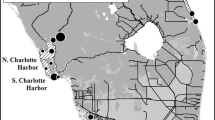Abstract
A study was conducted to assess the condition of estuaries in the EMAP Carolinian Province (Cape Henry, VA - St. Lucie Inlet, FL). Synoptic measures of sediment contamination, toxicity, and macroinfaunal condition were made at 82 and 86 stations in 1994 and 1995, respectively, in accordance with a probabilistic sampling design. These data were used to estimate percentages of degraded vs. undegraded estuarine area from the perspective of sediment quality. Each year a sizable portion of the province (36% in 1994, 51 % in 1995) showed some evidence of either degraded benthic assemblages, contaminated sediments in excess of bioeffect guidelines, or significant sediment toxicity (based on Ampelisca abdita and Microtox® assays). However, co-occurrences of a degraded benthos and adverse exposure conditions (sediment contamination and/or toxicity) were much less extensive – 17% of the province in 1994 and 25% in 1995. Each year only four sites, representing 5% of the province in 1994 and 8% in 1995, had degraded infauna accompanied by both sediment contamination and toxicity, suggesting that strong contaminant-induced effects on the benthos (based on such combined weight-of-evidence) were limited to a fairly small percentage of estuarine area province-wide. PCBs and pesticides (lindane, dieldrin, DDT and derivatives) were the most dominant contaminants over the two-year period. The broad-scale sampling design of EMAP was not intended to support detailed characterizations of potential pollutant impacts within individual estuaries. Thus, some estuaries classified as undegraded may include additional degraded portions outside the immediate vicinity of randomly sampled sites. Such localized impacts (not accounted for in the above estimates) were detected in this study at additional nonrandom supplemental sites near potential contaminant sources.
Similar content being viewed by others
References
American Society for Testing and Materials (ASTM): 1991, Guide for conducting 10-day static sediment toxicity tests with marine and estuarine amphipods, ASTM Standard Methods, 11.04, Method Number E-1367-90, ASTM, Philadelphia, PA.
Bulich, A.A.: 1979, Use of luminescent bacteria for determining toxicity in aquatic environments, In L. L. Marking and R. A. Kimerle (eds.), Aquatic Toxicology, 98–106, ASTM STP 667, American Society for Testing and Materials, Philadelphia, PA.
Chapman, P.M.: 1990, Sci. Total Environment, 97/98, 815–825.
Chapman, P.M., E.A. Power, R.N. Dexter, and G.A. Burton Jr: 1991, Integrative assessments in aquatic ecosystems, In G.A. Burton Jr. (ed.), Contaminated Sediment Toxicity Assessment, 313–340, Lewis Publishers, Chelsea, MI.
Culliton, T.J., M.A. Warren, T.R. Goodspeed, D.G. Remer, C.M. Blackwell and J.J. McDonough III: 1990, 50 years of population change along the Nation's coast, 1960–2010. National Ocean Service, NOAA, U.S. Department of Commerce, Rockville, MD. 41 p.
Hyland, J.L., T.J. Herrlinger, T.R. Snoots, A.H. Ringwood, R.F. Van Dolah, C.T. Hackney, G.A. Nelson, J.S. Rosen, and S.A. Kokkinakis: 1996, Environmental Quality of Estuaries of the Carolinian Province: 1994. Annual Statistical Summary for the 1994 EMAP-Estuaries Demonstration Project in the Carolinian Province, NOAA Technical Memorandum NOS ORCA 97, NOAA/NOS, Office of Ocean Resources Conservation and Assessment, Silver Spring, MD.
Long, E.R. and L. G. Morgan: 1990, The potential for biological effects of sediment-sorbed contaminants tested in the National Status and Trends Program, NOAA Technical Memorandum NOS OMA 52, U.S. Department of Commerce. National Oceanic and Atmospheric Administration, National Ocean Service, Rockville, MD.
Long, E.R., D.D. MacDonald, S.L. Smith, and F. D. Calder: 1995, Envir. Man., 19, 81–97.
MacDonald, D.D.: 1994, Approach to the assessment of sediment quality in Florida coastal waters. Vols. I–IV. Report prepared for Florida Department of Environmental Protection, Tallahassee, FL.
Microbics Corporation: 1992a, Microtox Manual (5 volume set), Carlsbad, CA.
Microbics Corporation: 1992b, Microtox Update Manual, Carlsbad, CA, 128 p.
Ringwood, A.H., A.F. Holland, R. Kneib, and P. Ross: 1996, EMAP/NS&T pilot studies in the Carolinian Province: Indicator testing and evaluation in southeastern estuaries. Final Report under Grant NA90AA-D-SG790 through S.C. Sea Grant College Program, S.C. Dept. of Natural Resources, Marine Resources Research Institute, Charleston, S.C. NOAA Technical Memorandum NOS ORCA 102.
Ringwood, A.H. and C. Keppler: In Press, Seed clam growth: A sediment bioassay developed in the EMAP Carolinian Province, Environ. Monitor. & Assess. Submitted May 1997.
Ringwood, A.H., R. Van Dolah, A.F. Holland, and M.G. Delorenzo: 1995, Year one demonstration project studies conducted in the Carolinian Province by Marine Resources Research Institute: Results and summaries, Year 1 Final Report under NOAA Cooperative Agreement No. NA470A0177, South Carolina Department of Natural Resources, Marine Resources Research Institute, Charleston, S.C.
Ringwood, A.H., R. Van Dolah, A.F. Holland, M.G. Delorenzo, C. Keppler, P. Maier, J. Jones, and M. Armstrong-Taylor: 1997, Year two demonstration project studies in the Carolinian Province by Marine Resources Research Institute: Results and summaries, Year 2 Final Report under NOAA Cooperative Agreement No. NA470A0177, South Carolina Department of Natural Resources, Marine Resources Research Institute, Charleston, S.C.
Shannon, C.E. and W. Weaver: 1949, The mathematical theory of communication, Univ. of Illinois Press, Urbana, 117 p.
Taylor, B.J. and B.J. Presley: 1993, GERG trace element quantification techniques, In: G.G. Lauenstein and A.Y. Cantillo (eds.), Sampling and analytical methods of the National Status and Trends Programs, National Benthic Surveillance and Mussel Watch Projects, 1984–1992, NOAA Technical Memorandum, NOS ORCA 71.
Wade, T.L., J.M. Brooks, M.C. Kennicutt II, T.J. McDonald, J.L. Sericano, and T.J. Jackson: 1993, GERG trace organics contaminant analytical techniques. In: G.G. Lauenstein and A.Y. Cantillo (eds.), Sampling and analytical methods of the National Status and Trends Programs, National Benthic Surveillance and Mussel Watch Projects, 1984–1992, NOAA Technical Memorandum, NOS ORCA 71.
Wade, T.L., B. Garcia-Romero, and J.M. Brooks: 1990, Chemosphere, 20, 647–662.
Wade, T.L., D.J. Velinsky, E. Reinharz, and C.E. Schekat: 1994, Estuaries, 17, 321–333.
Weisberg, S.B., J.A. Ranasinghe, D.M. Dauer, L.C. Shaffner, R.J. Diaz, and J.B. Frithsen: 1997, Estuaries, 20, 149–158.
Windom, H.L., S.J. Schropp, F.D. Calder, J.D. Ryan, R.D. Smith Jr., L.C. Burney, F.G. Lewis, and C.H. Rawlinson: 1989, Environ. Sci. Technol., 23, 314–320.
Author information
Authors and Affiliations
Rights and permissions
About this article
Cite this article
Hyland, J.L., Snoots, T.R. & Balthis, W.L. Sediment Quality of Estuaries in the Southeastern U.S.. Environ Monit Assess 51, 331–343 (1998). https://doi.org/10.1023/A:1005959907969
Issue Date:
DOI: https://doi.org/10.1023/A:1005959907969




